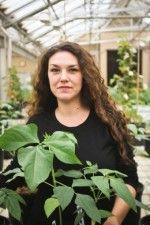The College of Agriculture and Life Sciences puts the A in Texas A&M and has been continuing research on plant varieties that withstand drought conditions.
The thing about agriculture research is that a lot of times its not flashy, but boy is it important, Hague said. Really improving agriculture is the difference between life and death for a lot of people on this planet.
The Department of Soil and Crop Sciences Department researches the genetic qualities of drought- resistant crops an effort that affects the livelihoods of people in more arid parts of the world, who depend on subsistence farming for survival.
Were looking to improve on that natural drought tolerance, said associate professor Steven Hague.
Cotton has a genetic makeup that strengthens the crop against drought. This is where Hague focuses his research.
Were trying to identify more robust root systems and thats a difficult process, he said. Obviously, its easy to look at a plant from the ground up, but to see whats going on beneath the ground is kind of difficult.
One of the major factors in determining a plants resistance to drought is the length of the root system. Searching beneath the soil allows Hague to see how the differing root systems of the crops affect their water retention and drought resistance. The other primary factor in a drought-resistant plant is what researchers call survival resistance, genetic factors within the plant that make it more tolerable of heat, such as leaves that prevent water loss.
Because of the typically arid climate, Texas has become home to an increasing crop yield.
If you look at the progress of yields from back in the 1800s up into today, we see a continuing climb in yields, said Travis Miller, a professor of soil and crop sciences and an extension specialist. Part of it is due to breeding and improving cotton, part of it is due to improved management fertilizers, but theres a lot of variables floating in the right direction.
The method for developing drought-resistant crops is complex. It involves work on the level of molecular breeding. Researchers take plants from a crop that exhibits the drought-resistant genes theyre looking for and cross breed with another plant, attempting to produce offspring with durability against drought.
Thats all breeding is, Hague said. Were just speeding up plant evolution.
Breeding often involves plant species from across the world. New world cotton in the U.S. generally produces a high crop yield and higher fiber quality as opposed to old world cotton from Asia, which is more drought resistant.
Hague said it would be ideal to cross both species and produce a variety of cotton that has a high yield and fiber quality and is more drought resistant.
Researchers are also working to discover drought-resistant genes in other plants.
Molecular and environmental plant sciences major Laura Masor is currently working on her Ph.D., mapping the genes that underlie drought tolerance in cowpea. Cowpeas are an old crop that researchers use to apply new technologies and help other crops.
They can look almost as yellow as straw and you would say, Theres no life left in that plant, and you apply water and they regrow, Masor said. You just give them a little bit of time and a little bit of water and theyll start growing.
Prof cultivates stronger crops to save lives
February 12, 2013

Donate to The Battalion
Your donation will support the student journalists of Texas A&M University - College Station. Your contribution will allow us to purchase equipment and cover our annual website hosting costs.



















